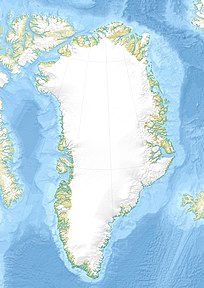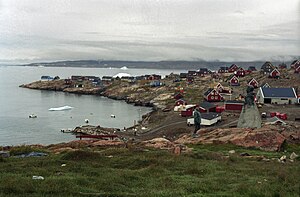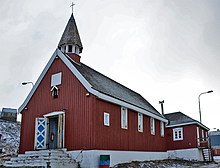Ittoqqortoormiit
| Ittoqqortoormiit (The inhabitants of that with big houses) | ||
|---|---|---|
| Scoresbysund Igtorĸortôrmît | ||
| Ittoqqortoormiit (2007) | ||
| Commune | Kommuneqarfik Sermersooq | |
| District | Ittoqqortoormiit | |
| Geographical location | 70 ° 29 ′ 6 ″ N , 21 ° 58 ′ 10 ″ W | |
|
|
||
| Residents | 345 (January 1, 2020) |
|
| Post Code | 3980 | |
| founding | 1924/25 | |
| Time zone | UTC-1 | |
Ittoqqortoormiit [ iˌtːɔqːɔˈtːɔːˌmːiːtˢʰ ] ( Kitaamiusut Illoqqortoormiut ; according to the old spelling Igtorĸortôrmît or Igdlorĸortôrmiut ; Danish Scoresbysund ) is a Greenlandic city in the district of Ittoqqortoormiit in the communeqarf .
location
Ittoqqortoormiit is by far the most remote place in Greenland. The nearest inhabited place is Bolungarvík in Iceland , on the other side of the Denmark Strait , 484 km away. The closest town in Greenland is Sermiligaaq , 780 km to the southwest. Mestersvig , only 206 km north-northwest, is not a place in the same sense, but just a constantly manned small military base with a changing crew of four. The small town of Uunarteq , just under eight kilometers to the south, has been deserted since 2004, and the town of Itterajivit, 13 km to the west, since 2005. Ittoqqortoormiit is located on Rosenvinge Bay on the south coast of Liverpool Land , an area that is separated by the Hurry Inlet (Kangersaajiva ) in the south and the Carlsbergfjord (Kangerterajitta Itterterilaa) in the north is separated from Jamesonland . The place is located on the northern bank of the exit of Kangertittivaq (Scoresby Sund), the largest fjord system in the world.
Ittoqqortoormiit is the only civil and inhabited place in Greenland that is in a different time zone from UTC-1 . The difference to most of Greenland (UTC-3) is two hours. Only part of the Northeast Greenland National Park (UTC) and the US Air Base Pituffik (UTC-4) also have different time zones.
history
Prehistoric times
When Greenland was settled, a settlement stream from which the Tunumiit emerged moved across the north coast to East Greenland and from there to the south. The area around Ittoqqortoormiit was therefore also temporarily inhabited and remains of past settlements were later discovered in the area. In 1822 the British navigator William Scoresby mapped the area. The name of the fjord and thus the Danish name of the city go back to him.
First considerations for a new settlement
After the Danish colonization of the region around Ammassalik , the population there grew rapidly at the beginning of the 20th century. It became evident that the hunting grounds there were no longer productive enough to feed all residents. In 1910, the doctor Alfred Bertelsen considered moving parts of the population to a new location for the first time. The following year, Harald Olrik (1883–1958), grandson of Christian Søren Marcus Olrik , who worked in the administration , issued a detailed plan in which the residents of Ammassalik were to be relocated far north, to the place where Ittoqqortoormiit is today lies. However, they showed no interest in Olrik's plan, which was then temporarily forgotten.
Unclear claims
In the following years, however, the Norwegian claims to the unpopulated parts of East Greenland, which were used by the Norwegians as fishing grounds, increased. Norway justified its claims with the fact that Greenland, along with the Faroe Islands and Iceland, had expressly gone to Denmark-Norway through the King's Act of 1665 . It was believed that when Norway was transferred to Sweden in the course of the Peace of Kiel in 1814, the Norwegian claims to ownership of Greenland were not automatically lost. Furthermore, it was believed that Denmark could hardly achieve sovereignty over the whole of Greenland simply by colonizing the inhabited west coast. Norway saw East Greenland as a no-man's-land , to which they themselves now made justified claims.
In 1916 it was therefore decided that Olrik's plan should be carried out so that Denmark could have more colonized territory in East Greenland. Ejnar Mikkelsen was enthusiastic about the plan, having come up with the idea years earlier together with Iver Iversen , and worked with Harald Olrik on the implementation. The administration had no money left, however, as the focus was on fishing in West Greenland, and the First World War once again diverted attention from Olrik's plan. When Denmark decided to sell its colony of Danish West Indies in the Caribbean to the United States in 1916 , they also demanded recognition of the sovereignty granted by the USA over the entire island of Greenland. In 1920 it also received recognition from the United Kingdom , France , Italy and Japan . In 1921 this statement was also requested from Norway, which had previously only given it orally in 1919 in return for the Danish recognition of Norwegian sovereignty over Svalbard . However, Norway refused to officially recognize Danish sovereignty over Greenland.
Reconsideration
In April 1922, Ejnar Mikkelsen demanded in the newspaper Nationaltidende that the resettlement of the residents of Ammassalik to the north should finally be carried out. Now it was believed, however, that the Danish fishing industry by Det Østgrønlandske Kompagni in the region did not require any further legitimation of Denmark's property claims. Finally, the director of the administration, Jens Daugaard-Jensen , agreed to consider expanding the colonization of East Greenland. However, Ejnar Mikkelsen and Harald Olrik were convinced that Jens Daugaard-Jensen's decision had already been made, namely that the establishment of a new colony in East Greenland was out of the question because he had not let them participate in the deliberations. Both protested vehemently against Daugaard-Jensen, whom they, together with the Danish Ministry of the Interior, accused of sabotaging the plan, although the Folketing Finance Committee would probably approve the financing. Ultimately, Mikkelsen and Olrik fell out and the latter eventually got out, so that Ejnar Mikkelsen finally wanted to carry out the plan on his own.
The Greenland Convention
In the same year Norway announced the construction of the Myggbukta weather station in Northeast Greenland, as Danish sovereignty over the area was still not recognized. The dispute over sovereignty in East Greenland flared up again, and after a legislative proposal was rejected in December 1922, a commission began negotiations between the two parties in September 1923. In early 1924 the De Ferslewske Blade newspaper , which Ejnar Mikkelsen had always supported, initiated the Scoresbysund Committee to push the plan through. The committee consisted of the hydrograph Carl Frederik Wandel , the newspaper's co-owner and lawyer Carl Levin , the polar explorer Gustav Frederik Holm , who had already colonized Ammassalik, the historian Louis Bobé , the shipowner Christen Kraemer , the former Greenland inspector Ole Bendixen , the editor the newspaper Valdemar Galster and Ejnar Mikkelsen himself. The Danish Ministry of the Interior, the administration and Det Østgrønlandske Kompagni worked against Mikkelsen and the committee. The company sent Teddy to the region as early as 1923 .
In 1924, however, the Folketing Election also took place. With a change of government Thorvald Stauning was now at the head of the Danish government. He was part of the negotiations to clarify claims in East Greenland. Work was carried out on the Greenland Agreement, which allowed Norway to fish and Denmark to build the new settlement. However, neither party was willing to compromise and both Denmark and Norway were dissatisfied with the agreement. In addition, people in Greenland felt completely ignored, as Grønlands Landsråd had not been given a say. Ejnar Mikkelsen also harshly criticized the agreement. The general opinion was that Norway's intensive fishing off the East Greenland coast was responsible for the decline in yields in Ammassalik, which is why they did not want to accept that Norway could continue fishing there. Norway, on the other hand, was convinced that Denmark would certainly not be allowed to found a colony in Norwegian interests. After all, they also referred to the centuries-old royal law, according to which Norway was legally in possession of the area.
Stauning did not understand the coming agreement to mean that a colony should be established. The new interior minister, Christen Nielsen Hauge , finally convinced the finance committee that the colonization should not be financed. The Scoresbysund Committee had to collect money on its own to carry out the plan. A little later, however, they rowed back because they wanted to prevent Norway from taking over the colonization of East Greenland, which according to the agreement would have been quite conceivable. The Ministry of the Interior, the administration and the committee got together and finally it was decided on June 17th that the colonization should be carried out according to the plans of the committee, although the Ministry of the Interior and the administration were not completely convinced. On July 1st, negotiations on the Greenland Agreement were also concluded. In the summer the information was received that the Teddy had not reached its destination and had been destroyed in the Greenland ice. The Kompagni had lost her second ship and had to close.
The establishment of Ittoqqortoormiit
On July 10, 1924, Grønland left Copenhagen to carry out the colonization. After a stopover in Iceland , they reached Scoresby Sund. The ship was badly damaged by ice, but four suitable spots were found, houses were built and six men hibernated there to start preparations for the new settlement. In addition to Ittoqqortoormiit, the nearby settlements of Uunarteq (Cape Tobin), Itterajivit (Cape Hope) and Innakajik (Cape Stewart) should be founded.
Johan Petersen was then asked to find residents from Ammassalik who could be taken there. The population was not too enthusiastic about the planned relocation, but it should later show that it would be completely worth it. 85 men were finally on the Gustav Holm (new name of Grønland ), which drove from Ammassalik to Ísafjörður , where the head catechist Sejer Abelsen was to be ordained pastor of the new place. In Iceland, however, 14 settlers died from the flu , so that Johan Petersen only reached Ittoqqortoormiit with 70 men. From then on he acted as the first colonial administrator of the place, in which the hunting yields were initially five times higher than in Ammassalik.
Elimination of the Norwegian claims
Norway continued to own the uninhabited areas of East Greenland. In 1931 Eirik Raudes Land was proclaimed north of Ittoqqortoormiit and Fridtjof Nansen's Land south of Ammassalik in the following year . Both seizures ended on April 5, 1933 with an arbitration award from the Permanent International Court of Justice .
Later developments
In 1934 the settlement of Kangersittuaq (Sydkap) was founded on the north bank of Hall Bredning and in 1944 the settlement of Kangikajik (Cape Brewster) on the south bank of Scoresby Sund.
It was not until the 1960s that East Greenland, like the area around Qaanaaq, was fully integrated into the Greenlandic administrative structures.
In 2005 the last resident left Itterajivit and in 2003 Uunarteq was left. At this point in time, the other settlements had not existed for decades. Since then, Ittoqqortoormiit has been the only inhabited place in the former municipality, apart from the staff at Nerlerit Inaat Airport .
In 2008, 9 polar bears were sighted, but in 2018 there were at least 21 polar bear incidents. The increase is attributed to the decline in polar ice in the wake of the climate crisis and the associated loss of habitat for these animals.
economy
A large part of the population works in administration. Tourism also generates a certain economic output. There is a tourist office and a guest house for this purpose. Fishing and hunting play a rather subordinate role. There are musk oxen , hares , foxes , ringed seals , polar bears and whales hunted. In a nearby polynya are cod caught. Crab grebes , guillemots and kittiwakes are also hunted .
Infrastructure and supply
Due to the remoteness, shipping in Ittoqqortoormiit plays a less pronounced role. The Ittoqqortoormiit Heliport leads to Nerlerit Inaat Airport, 38 km to the north-west , from where you can fly to West Greenland and Iceland. There is some car traffic within the city. Other transport options are with dog sledding .
Nukissiorfiit is responsible for the electricity and water supply in Ittoqqortoormiit. Garbage is stored in the landfill and partly burned openly. There is no sewerage system and a large part of the buildings has dry toilets. TELE Greenland is responsible for the telecommunications connection of the city. The residents are supplied with goods via a Pilersuisoq branch.
Development
The students in Ittoqqortoormiit visit the Ejnar Mikkelsenip Aluarpia. You can also complete the preparatory exam. There is a day-care center, a nursing home, a hospital and a police station. There is also a service building, an assembly building, two kiosks, an office and the Ittoqqortoormiit Museum, which is located in a building from 1930.
climate
| Ittoqqortoormiit | ||||||||||||||||||||||||||||||||||||||||||||||||
|---|---|---|---|---|---|---|---|---|---|---|---|---|---|---|---|---|---|---|---|---|---|---|---|---|---|---|---|---|---|---|---|---|---|---|---|---|---|---|---|---|---|---|---|---|---|---|---|---|
| Climate diagram | ||||||||||||||||||||||||||||||||||||||||||||||||
| ||||||||||||||||||||||||||||||||||||||||||||||||
|
Climate table for Ittoqqortoormiit
Source: Temperatures 1961–1990, precipitation 1949–1960
|
||||||||||||||||||||||||||||||||||||||||||||||||||||||||||||||||||||||||||||||||||||||||||||||||||||||||||||||||||||||||||||||||||||||||||||||||||||||
Sons and daughters
- Jens Napaattooq (* 1966), politician (Partii Naleraq)
Population development
The population of Ittoqqortoormiit rose to 539 by 2006, but has since declined sharply. Since 2006 the city has lost over a third of its population.

literature
- Ejnar Mikkelsen: neighbors of the North Pole. Establishing a colony in East Greenland. Übers. Luise Wolf . Reclam, Leipzig 1927
Web links
Individual evidence
- ↑ Map with all official place names confirmed by Oqaasileriffik , provided by Asiaq
- ↑ a b c Ittoqqortoormiit in Den Store Danske
- ↑ a b c d e f Søren Andreasen: Ejnar Mikkelsen and oprettelsen af kolonien Scoresbysund. Bachelor thesis at Ilisimatusarfik 2009.
- ↑ Spencer Apollonio: Lands that Hold One Spellbound: A Story of East Greenland . University of Calgary Press, Calgary 2008, ISBN 978-1-55238-240-0 , pp. 147–156 ( limited preview in Google Book search).
- ↑ a b Ittoqqortoormiit at groenlandkreuzfahrt.de
- ^ Hanne Sandell, Birger Sandell: Cape Hope: A Settlement and Its Resources . In: Arctic Anthropology . tape 23 , no. 1 , 1986, pp. 281-298 , JSTOR : 40316116 .
- ^ Siberian Island: State of emergency due to "aggressive polar bears" orf.at, February 9, 2019, accessed February 10, 2019.
- ↑ a b c Ittoqqortoormiit at sermersooq2028.gl (.pdf)
- ↑ Climate average values for Greenland ( memento of the original from September 2, 2017 in the Internet Archive ) Info: The archive link was inserted automatically and has not yet been checked. Please check the original and archive link according to the instructions and then remove this notice. on the website of the Danish Meteorological Institute
- ↑ Colwyn Jones: Greenland Expedition 1996. Expedition Report, The Scottish Mountaineering Club, p. 29. (.pdf; 2.7 MB)
- ↑ Population Ittoqqortoormiit 1977-2020 at bank.stat.gl






